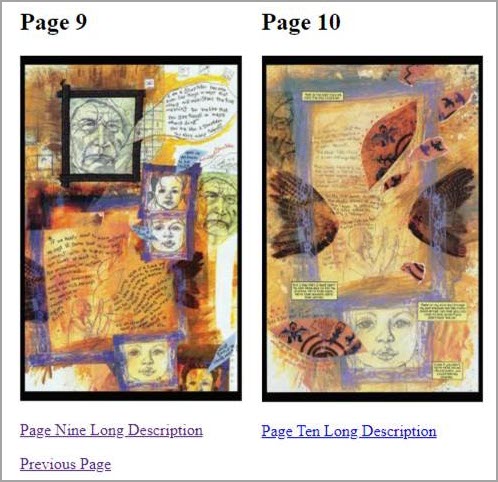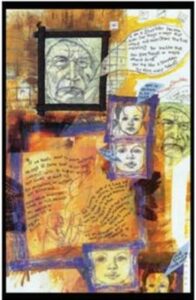Echo Vision Quest
Through doing formal analysis, long-form descriptions of the images and pages were drafted.
The team chose to use long-form descriptions instead of alternative text because of the complex imagery in the graphic novel, e.g., Echo Vision Quest. After drafting the descriptions, the team created HTML pages that were added to the course site. This allowed students to digitally access the graphic novel either by viewing the images (similar to a traditional PDF) or reading the written long-description with assistive technologies.
Each complex imagery requires a long description with a link to the next page for further information; students can activate the link to learn more about each image. The alternative description benefits everyone, including those with vision impairments or cognitive disabilities. A description of the imagery is included (below) for further reading.

Echo Vision Quest – Page 9 Long Description
This page is mostly in the yellow, orange, and amber color scheme and filled with dry-brushed paint. In the upper left corner around a realistic sketch of the shaman are more pictographs and labels. They blend into the background and in some cases disappear behind orange and brown brushstrokes. The right edge of the portrait aligns with the vertical center of the page. The portrait is framed by a thin beaded ribbon on all sides.
To the right of the portrait are two sketches of young Maya. They are the same sketches as the first two on Page 6, only smaller in proportion. They are framed in the purple lace ribbon. To the right of them, drawn directly onto the page, is a pencil sketch of the shaman. This stair-step-like shape of portraits of Maya and the shaman carry out a dialogue through text boxes.
From the top right, the shaman’s words are written in a large white speech bubble that occupies the upper right corner of the page, “I am a storyteller because I can say things in ways that others will understand the true meaning. You are like that. You see things in ways others do not. You are also a storyteller. You have many talents.”
The first sketch of young Maya asks from a light-blue, cut-paper text bubble shaped like an elliptical leaf, “How do you know to be this?” and written in red pen beside it, “this kind of story teller.”
The sketch of the shaman to the right of the sketches of young Maya answers, “I went on a vision quest.”
The bottom sketch of young Maya asks, “What’s a vision quest?” again written on a blue, cut-paper text bubble.
There are no Yellow Text Boxes on this page, instead the conversation comes from drawn and cut text bubbles with handwritten dialogue inside. The dialogue is between the shaman and young Maya. It is the first time in the series of pages that dialogue is presented in this way. Before, Maya’s text bubbles came from her mouth, but there were no responses from others. Now, the shaman directly responds to her questions in text bubbles of his own.
The lower half of the page contains a large square, framed by the purple lace. To the left and right of this square are brush strokes applied to suggest the shape and pattern of hawk feathers. Inside the square is the drawing of a crouched man. Both of his arms are raised. Three leaf shapes come from his mouth to suggest talking, but there is no text inside of these. The text is around him at angles, written in black pen directly onto the orange background. It says, “If we really want to know ourselves, we must at some point in our lives connect with a higher wisdom that knows all about us. Our weaknesses, our mistakes, our potentials. Many Native American tribes do this through our meditation known as a vision quest.”
“The setting aside of a time and place, alone in nature, to connect with the higher power and explore that which is within. Somewhere in that space of time as we are questing, answers come. It’s an opportunity to know more about ourselves and our choices in life.”
At the bottom right of this image, sharing a lacy purple ribbon frame with the shaman is a close-up sketch of young Maya. She has a soft, contented smiling expression as she looks out at the viewer. Then, peaking over the bottom right corner of the page is another portrait of young Maya, from the nose up. Hints of pigtails are behind her ears. There is a blue, cut-paper text bubble coming from her that says, “What sounds do clouds make?”
